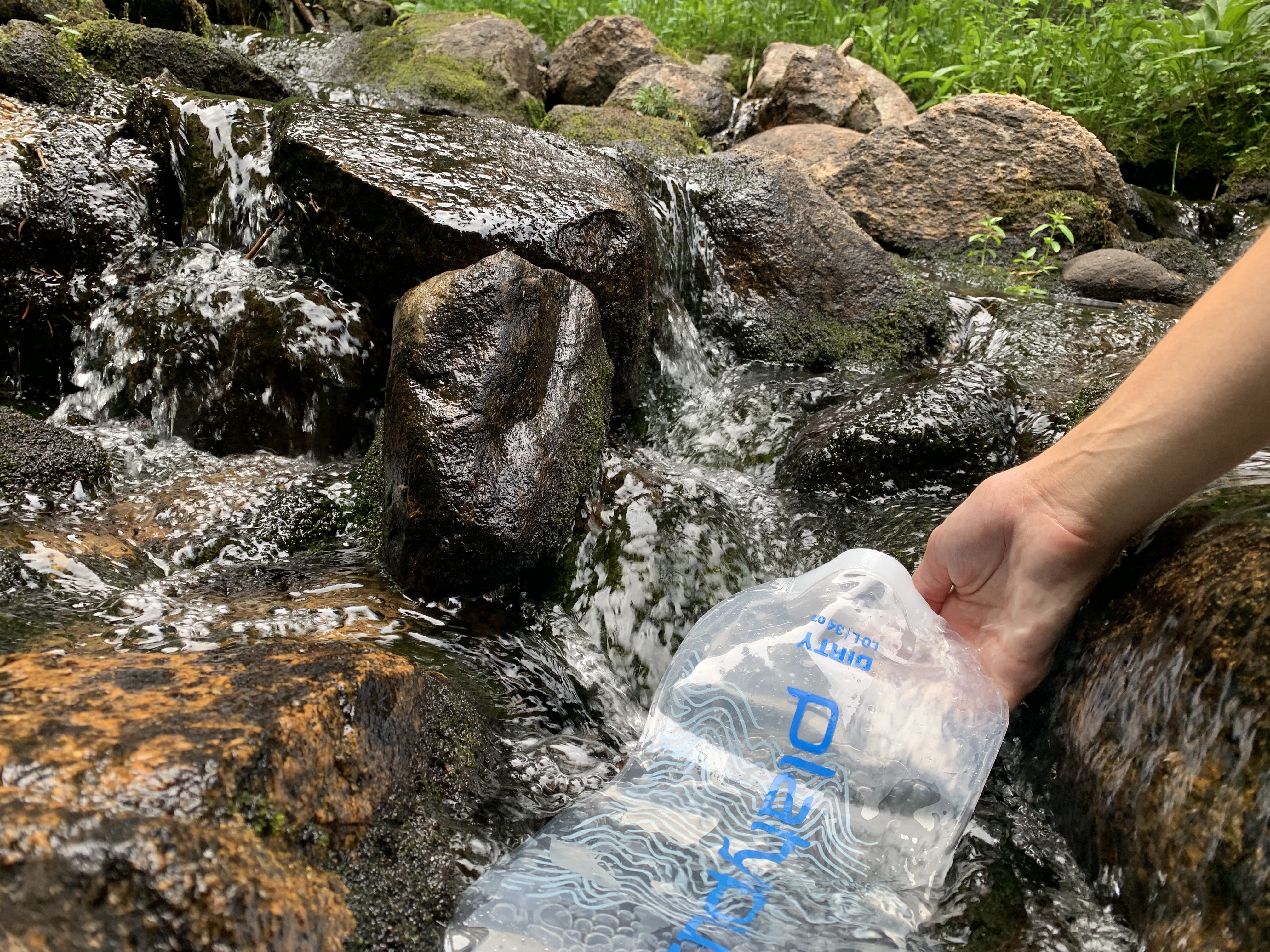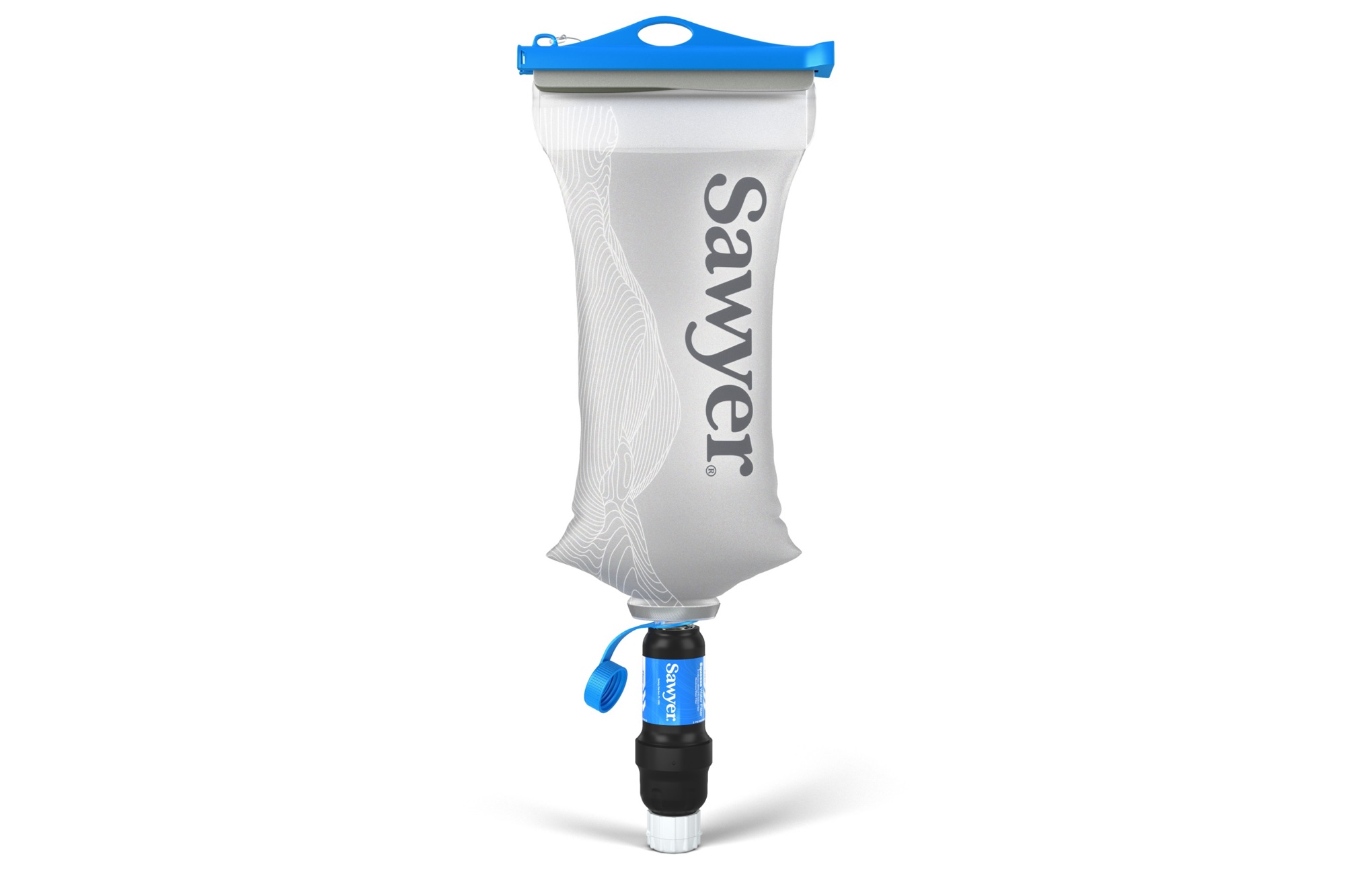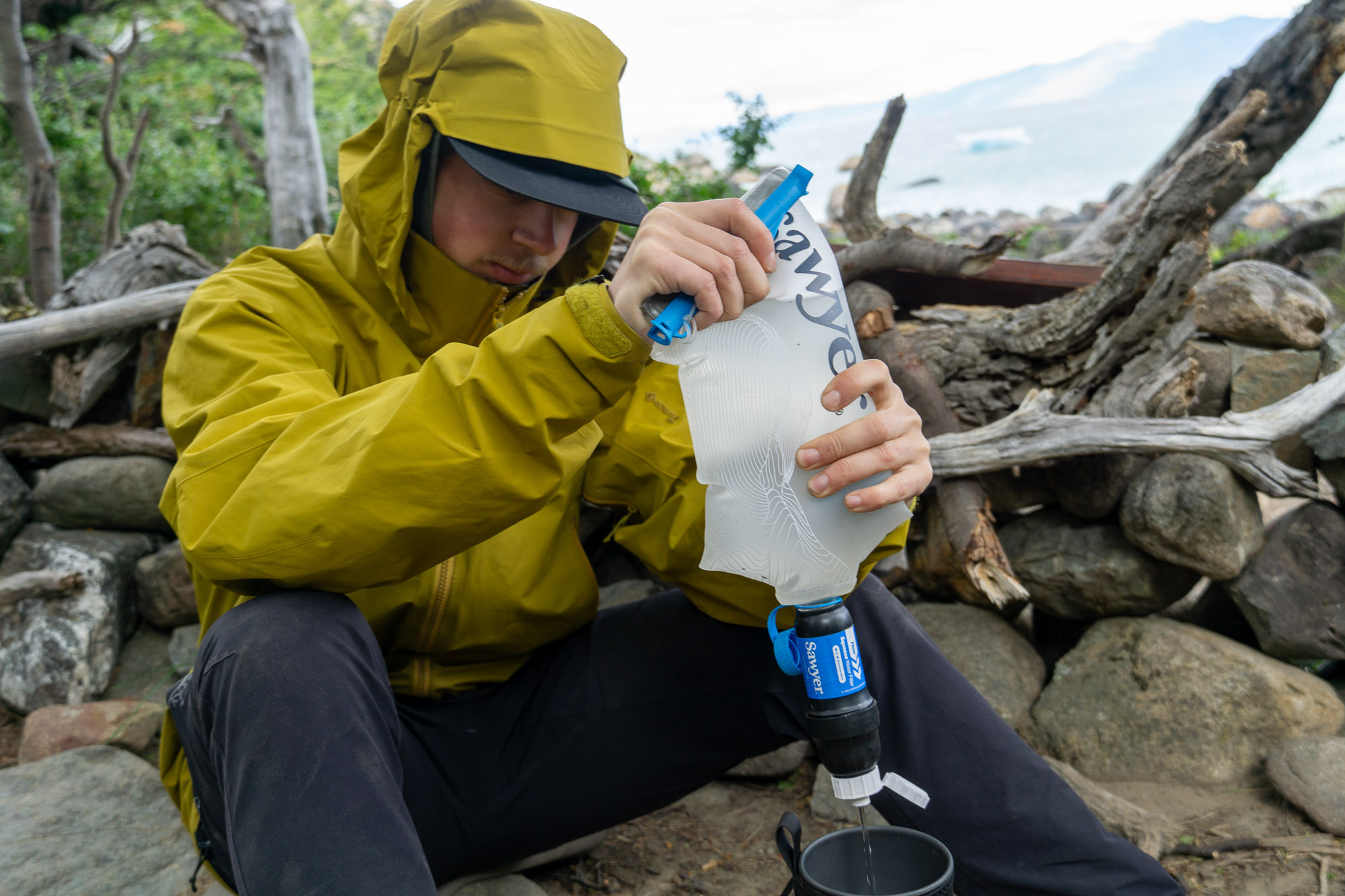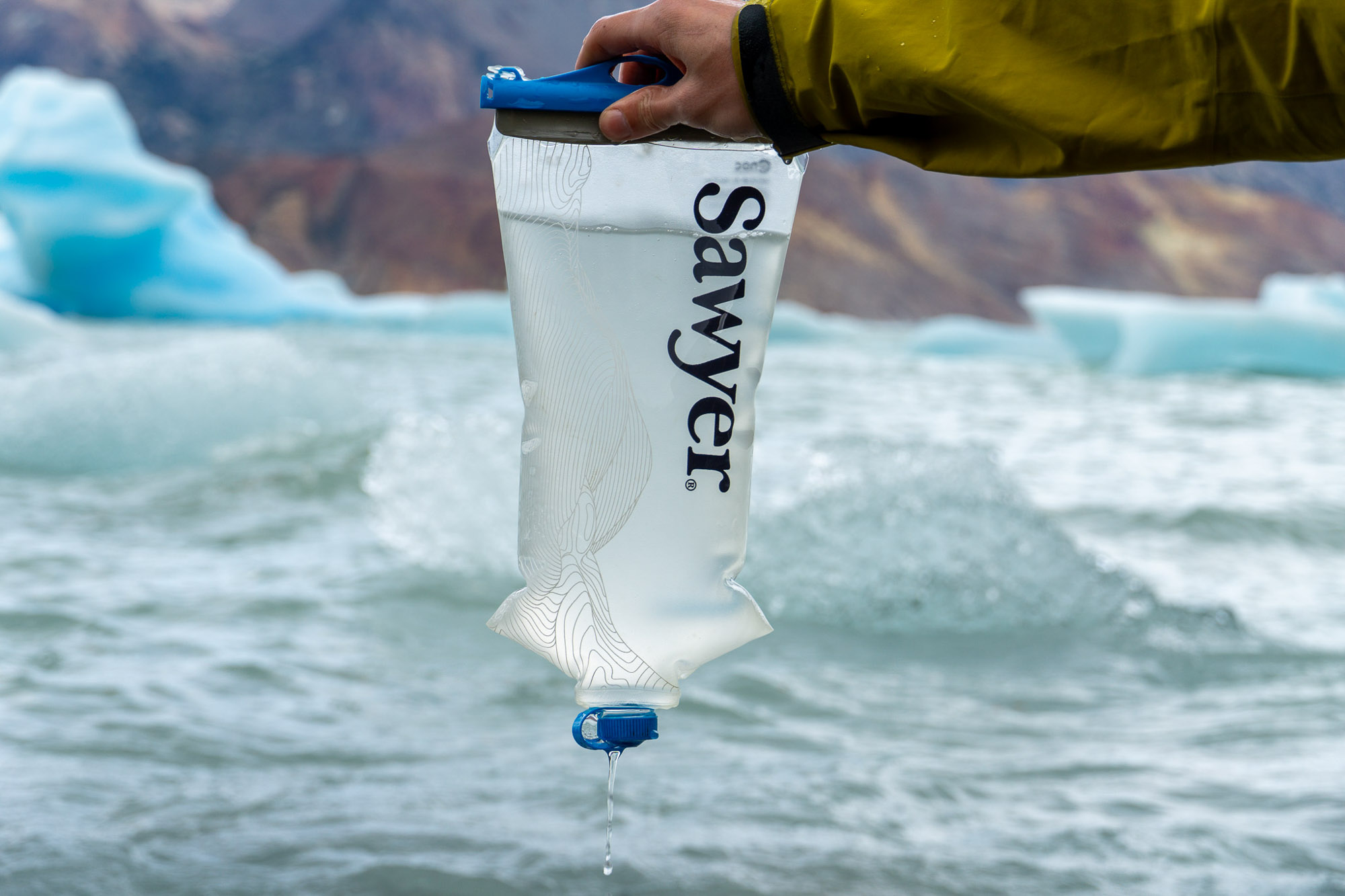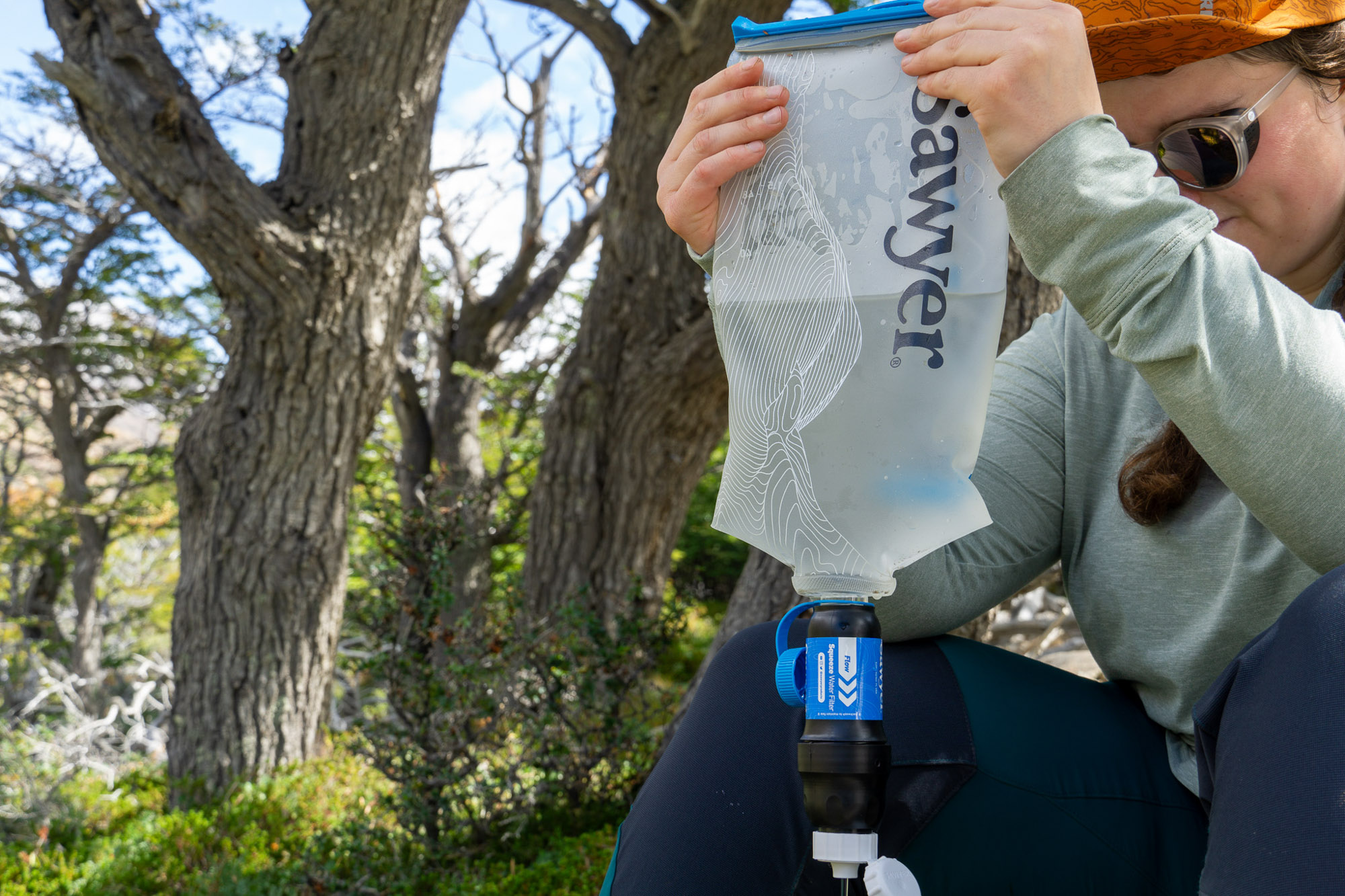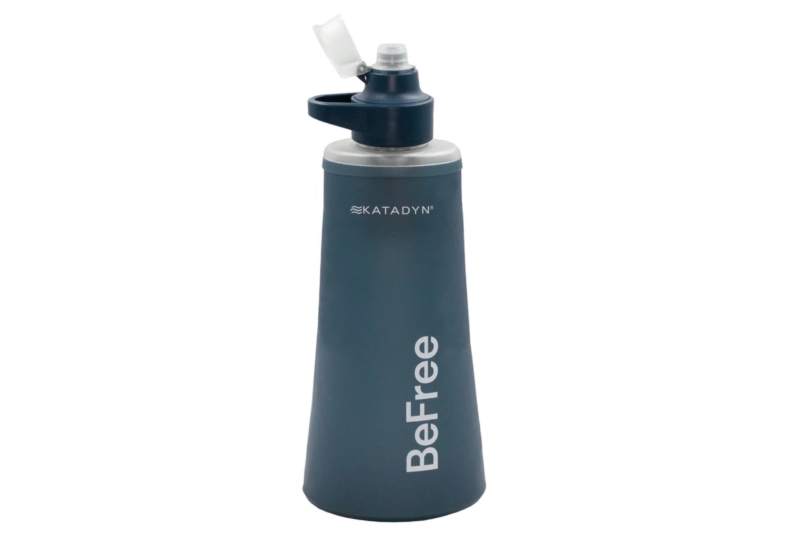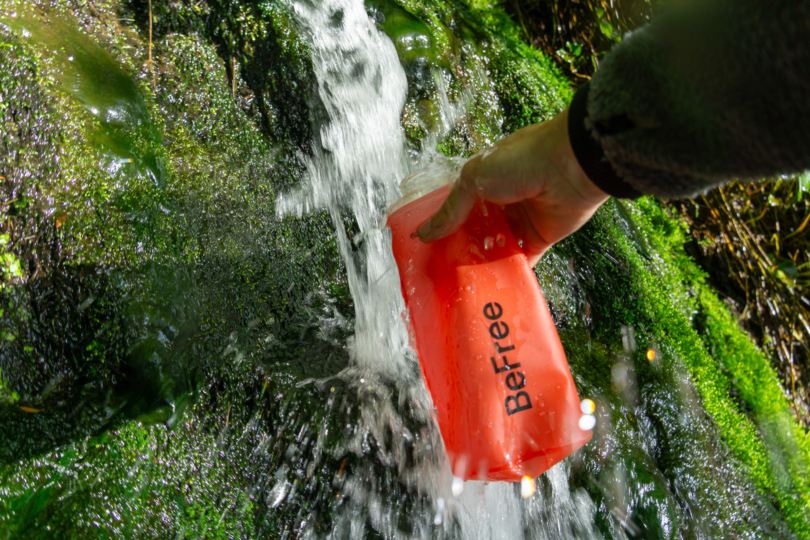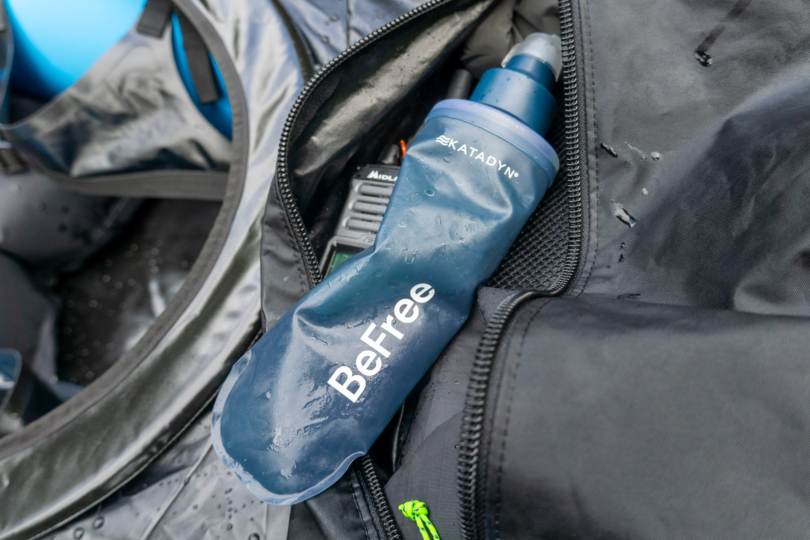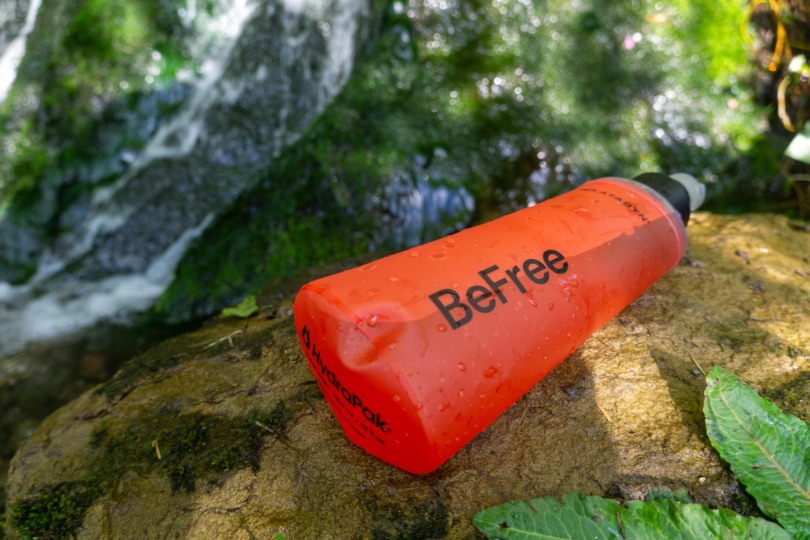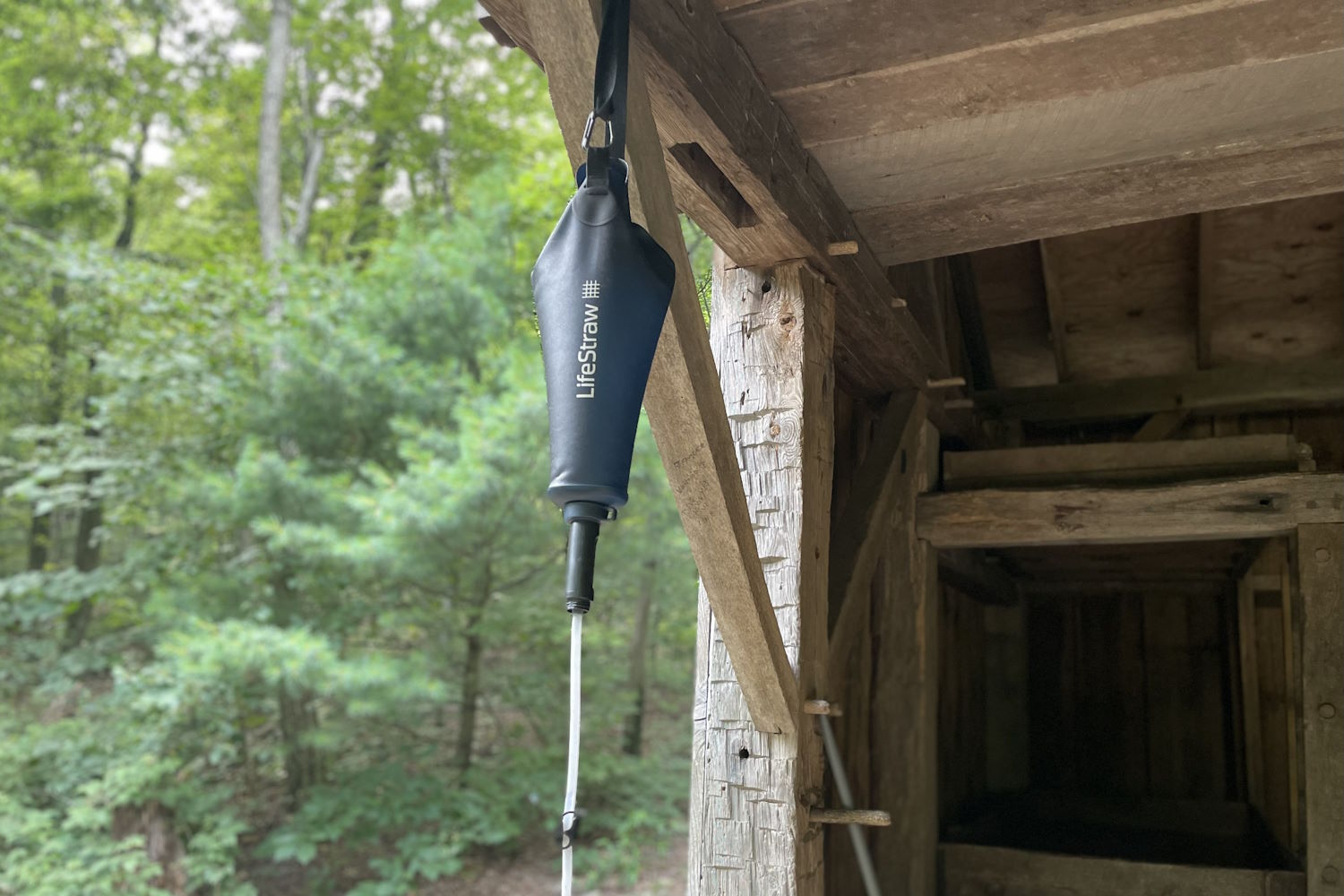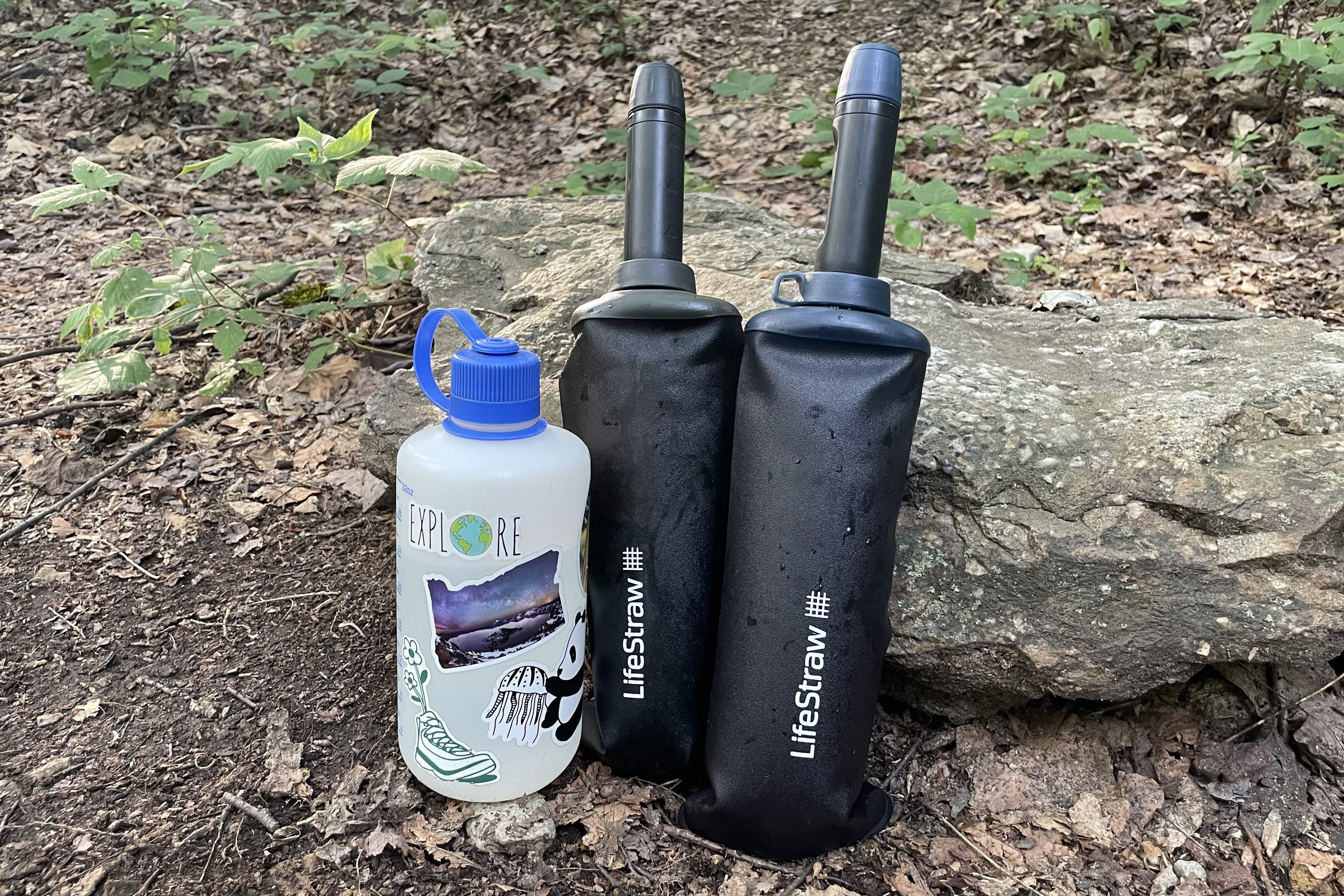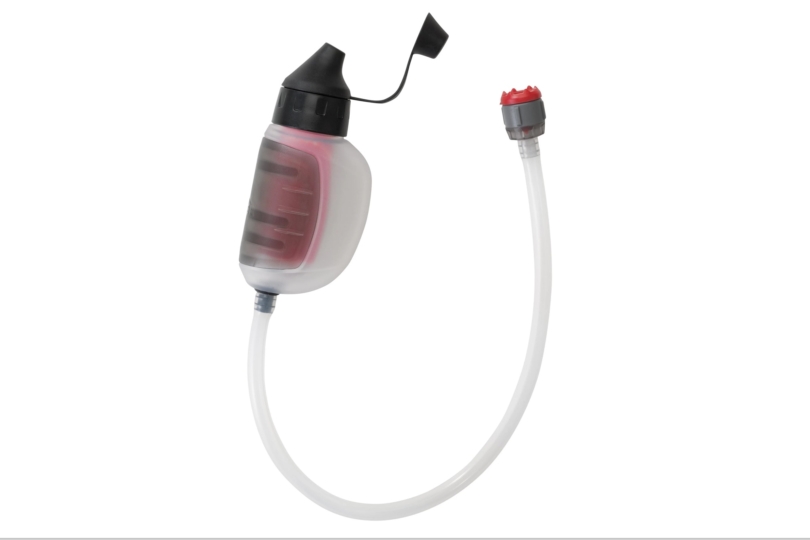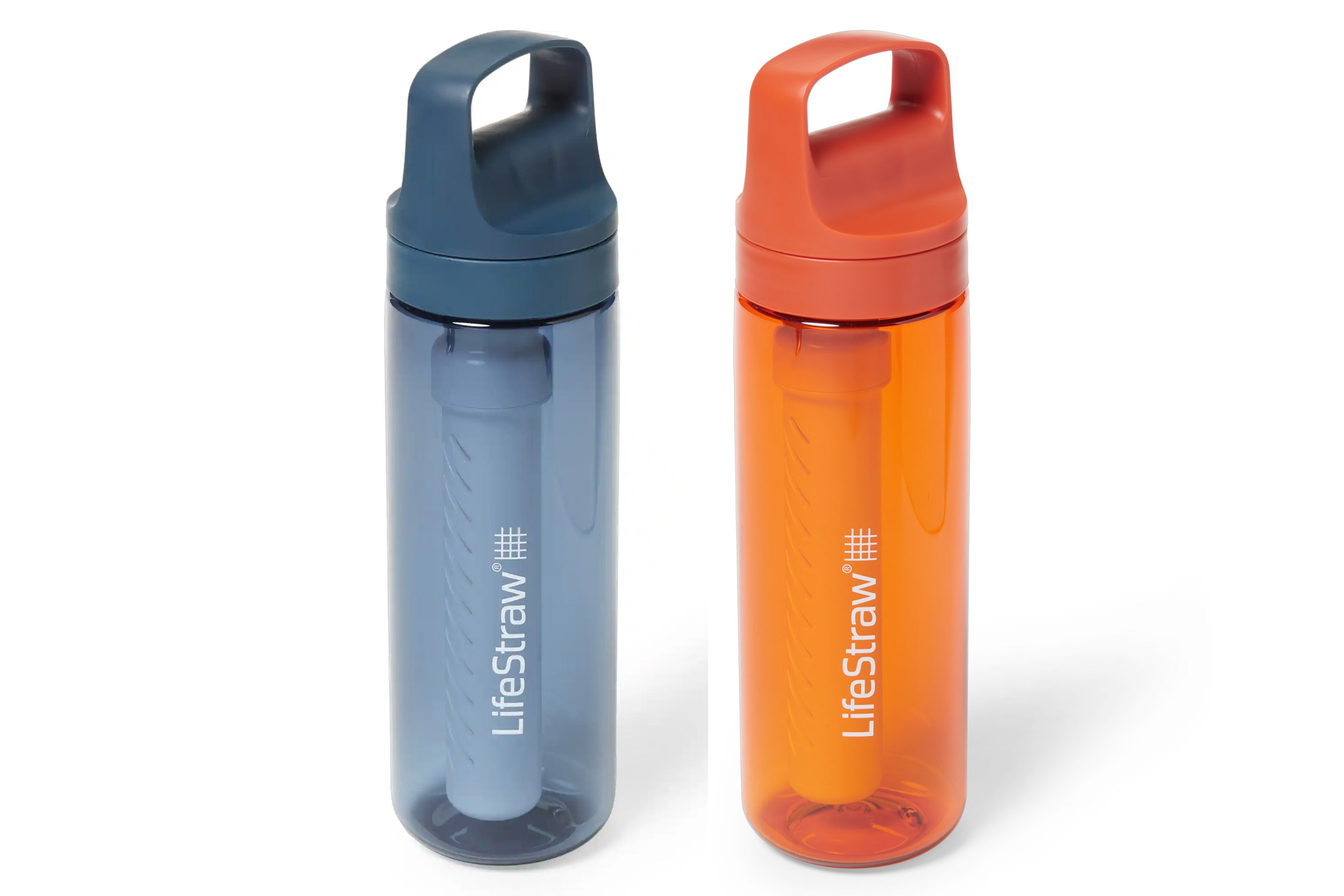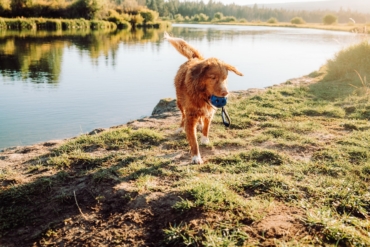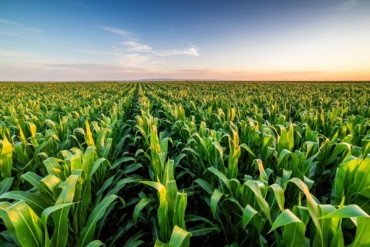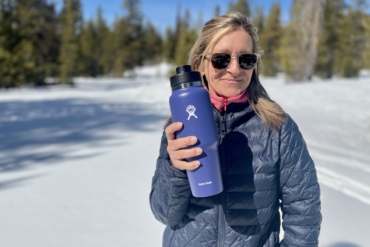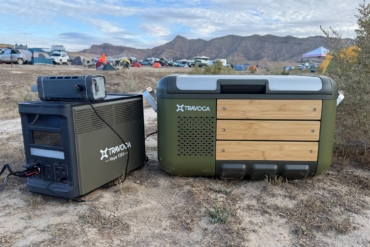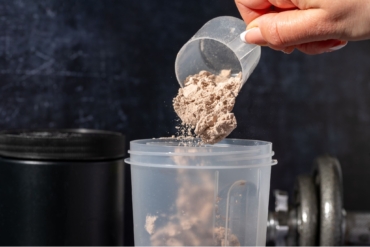Little else ruins a good backpacking trip like a midnight run for the bushes. I’ve been there, and I’m not keen on going back, which is why our experts have found the best backpacking water filters. I’ve spoken to thru-hikers, hunters, and mountaineers, and logged a not small number of miles ourselves, filtering water along the way.
Our experts collectively tested a wide range of filters for the creation of this guide, from top-pick Platypus QuickDraw to the budget-conscious LifeStraw Personal. I’ve been squeezing water through countless tubes and dropping tablets in Nalgenes each season to bring you the streamlined selection of 15 filters you see today.
Rest assured, I would trust every model in this guide to keep me safe and hydrated in the backcountry.
Editor’s Note: We updated our Backpacking Water Filters guide on August 29, 2025, to add the Katadyn BeFree AC, an updated version of our favorite fill-and-go filter that now sports a taste-neutralizing carbon filter. We’ve also added the MSR TrailShot to our recommendations, as it impressed as a trail runner’s ideal water filtration solution.
The Best Backpacking Water Filters of 2025
Platypus QuickDraw
-
Treatment Time
9.0
-
Ease of Use
8.0
-
Durability
7.0
-
Weight & Packed Size
8.0
- Weight: 3.3 oz.
- Filter Type: Bottle/inline filter
- Filter Life: 1,000 liters
- Flow Rate: 3 L/min
- Filter Pore Size: 0.2 microns
- Removes Particulates and Bacteria: Yes
- Removes Protozoa: Yes
- Removes Viruses: No
Pros
- Impressive 3 liter per minute flow rate
- Filter interfaces with both Platypus reservoir and popular soft-drink threaded bottles
- O-ring sealed caps for both the inlet and output sides of the filter
- Integrity Check allows you to ensure your filter membrane is still safe to use
- O-ring in inlet side is indexed to not fall out
Cons
- 0.2 micron filter size isn't as fine as some filters out there
- Dirty water bag isn't immune from punctures or wear
LifeStraw Personal
-
Treatment Time
7.0
-
Ease of Use
6.0
-
Durability
7.0
-
Weight & Packed Size
6.0
- Weight: 1.6 oz.
- Filter Type: Straw filter
- Filter Life: 4,000 L
- Flow Rate: N/A
- Filter Pore Size: 0.2 microns
- Removes Particulates and Bacteria: Yes
- Removes Protozoa: Yes
- Removes Viruses: No
Pros
- Budget price
- Great for daily adventures
- Lasts for up to 4,000 L, plenty for almost any outdoor adventurer
- Lightweight at 2 ounces
Cons
- Won't work for filtering water into a bladder or bottle for reserve
- Requires emptying before storage
Sawyer Squeeze
-
Treatment Time
8.0
-
Ease of Use
7.0
-
Durability
9.0
-
Weight & Packed Size
7.0
- Weight: 2.5 oz.
- Filter Type: Bottle/inline filter
- Filter Life: 100,000 gallons
- Flow Rate: 1.7 L/min
- Filter Pore Size: 0.1 microns
- Removes Particulates and Bacteria: Yes
- Removes Protozoa: Yes
- Removes Viruses: No
Pros
- New Cnoc bladders are much better than previous
- Simple to use design
- Lightweight at under 3 oz.
- Packable
- Integrated flip-cap keeps outlet clean (with extra gasket beneath)
Cons
- Inline filter setup isn't flawless
- No specified integrity test
- No cap on the dirty side
Katadyn BeFree AC
-
Treatment Time
8.0
-
Ease of Use
9.0
-
Durability
8.0
-
Weight & Packed Size
8.0
- Weight: 3 oz.
- Filter Type: Bottle filter
- Filter Life: 1,000 L
- Flow Rate: 2 L/min
- Filter Pore Size: 0.1 microns
- Removes Particulates and Bacteria: Yes
- Removes Protozoa: Yes
- Removes Viruses: No
Pros
- Easy to dip and go
- Can run the filter with or without the carbon filter
- Tough flip cap
- Available in a double layer flask
Cons
- Carbon filter doubles your filter time
- Tough to get all the water to come out from flask
Katadyn BeFree Gravity 3L
-
Treatment Time
8.0
-
Ease of Use
8.0
-
Durability
7.0
-
Weight & Packed Size
7.0
- Weight: 6.8 oz.
- Filter Type: Gravity Filter
- Filter Life: 1,000 L
- Flow Rate: 2 L/min
- Filter Pore Size: 0.1 microns
- Removes Particulates and Bacteria: Yes
- Removes Protozoa: Yes
- Removes Viruses: No
Pros
- Requires no complicated backflushing
- High flow rate
- Easy to hang from a tree limb, etc.
Cons
- You’ll need a place to hang the filter
- Heavy
Grayl GeoPress Bottle
-
Treatment Time
8.0
-
Ease of Use
7.0
-
Durability
7.0
-
Weight & Packed Size
6.0
- Weight: 15.9 oz.
- Filter Type: Bottle filter/purifier
- Filter Life: 65 gallons
- Flow Rate: 5 L/min
- Filter Pore Size: N/A
- Removes Particulates and Bacteria: Yes
- Removes Protozoa: Yes
- Removes Viruses: Yes
Pros
- Convenient and great for travel
- Durable polypropylene bottle
- Activated carbon doesn’t just filter water, but purifies it as well
- One-way valve allows for drink mixes to be used
Cons
- More expensive option
- Inability to use filter separate from bottle housing
Other Water Filters We Trust
Clean water in the backcountry is essential, and the seven filters I’ve awarded above are just about the best of the lot. That doesn’t mean they’re the only options out there, and I’ve used plenty of other worthy filters on our travels. Check out the lineup below before making your choice.
-
Treatment Time
7.0
-
Ease of Use
8.0
-
Durability
7.0
-
Weight & Packed Size
7.0
- Weight: Straw: 2.3 oz.; Squeeze Filter: 3.2 oz.
- Filter Type: Straw: straw; Squeeze Filter: bottle/gravity filter
- Filter Life: Straw: 4,000 L ; Squeeze Filter: 2,000 L
- Flow Rate: Straw: N/A ; Squeeze Filter: 3 L/min
- Filter Pore Size: 0.2 microns
- Removes Particulates and Bacteria: Yes
- Removes Protozoa: Yes
- Removes Viruses: No
Pros
- Lightweight design
- Durable and sleek looking
- Quick flow rate of 3 liters per minute on the Squeeze filter
Cons
- On the heavier side
- Squeeze filter has a shorter filter life than some
-
Treatment Time
8.0
-
Ease of Use
7.0
-
Durability
8.0
-
Weight & Packed Size
6.0
- Weight: 1 lb., 1.3 oz.
- Filter Type: Pump filter/purifier
- Filter Life: 10,000 L
- Flow Rate: 2.5 L/min
- Filter Pore Size: 0.2 microns
- Removes Particulates and Bacteria: Yes
- Removes Protozoa: Yes
- Removes Viruses: Yes
Pros
- Self-cleaning ability cuts down on maintenance time
- Super long filter life of 10,000 liters
- Faster flow rate than MiniWorks EX
Cons
- Heavy at more than a pound
- Expensive
-
Treatment Time
5.0
-
Ease of Use
7.0
-
Durability
9.0
-
Weight & Packed Size
9.0
- Weight: 0.9 oz.
- Filter Type: Chemical purifier
- Filter Life: 1 liter per tab
- Flow Rate: 1 L/4 hours
- Filter Pore Size: N/A
- Removes Particulates and Bacteria: Only bacteria
- Removes Protozoa: Yes
- Removes Viruses: Yes
Pros
- Destroys bacteria, viruses, and protozoa including cryptosporidium
- Ultralight and easy to stash away
- Budget-friendly
Cons
- 4-hour wait time to fully clean water
- Expires after 5 years
- Slight odor/taste, as with most chemical treatments
-
Treatment Time
6.0
-
Ease of Use
6.0
-
Durability
7.0
-
Weight & Packed Size
8.0
- Weight: 5 oz.
- Filter Type: Handheld
- Filter Life: 2,000 liters
- Flow Rate: 1 L/min
- Filter Pore Size: 0.2 microns
- Removes Particulates and Bacteria: Yes
- Removes Protozoa: Yes
- Removes Viruses: No
Pros
- Easy to drink and go without any set up required
- Small prefilter on tube keeps the main filter running quick
- Simple to field clean, and can be rebuilt with new filter element
- Small packed size
Cons
- Slower pump rate makes it tough to filter large amounts of water
- No dirty water vessel means you'll need another container to carry water in
- Bit pricey
-
Treatment Time
7.0
-
Ease of Use
7.0
-
Durability
7.0
-
Weight & Packed Size
6.0
- Weight: 9 oz.
- Filter Type: Bottle/straw filter
- Filter Life: 4,000 L
- Flow Rate: N/A
- Filter Pore Size: 0.2 microns
- Removes Particulates and Bacteria: Yes
- Removes Protozoa: Yes
- Removes Viruses: No
Pros
- 2-stage filter improves taste
- Affordable
- Durable build
- Sleek design with lots of fun colors
Cons
- Straw doesn't extend all the way to the bottom of bottle
- Cover cap unscrews relatively easily
- Can't filter water into a larger vessel for storage
-
Treatment Time
7.0
-
Ease of Use
7.0
-
Durability
8.0
-
Weight & Packed Size
6.0
- Weight: 1 lb.
- Filter Type: Pump filter
- Filter Life: 2,000 L
- Flow Rate: 1 L/min
- Filter Pore Size: 0.2 microns
- Removes Particulates and Bacteria: Yes
- Removes Protozoa: Yes
- Removes Viruses: No
Pros
- Easy to clean filter element
- Unique carbon/ceramic filter design cleans heavy metals and organic compounds
- Interfaces with MSR Dromedary bags or Nalgene bottles
- Uptake hosing uses a small float to pull from the cleanest water
Cons
- Pretty expensive
- Heavy at 1 pound
-
Treatment Time
6.0
-
Ease of Use
7.0
-
Durability
7.0
-
Weight & Packed Size
6.0
- Weight: 1 lb., 3 oz.
- Filter Type: Gravity filter
- Filter Life: 3,000+ L
- Flow Rate: 1 L/2 min
- Filter Pore Size: 0.2 microns
- Removes Particulates and Bacteria: Yes
- Removes Protozoa: Yes
- Removes Viruses: Yes
Pros
- Works great for group travel in the backcountry
- Requires no backflushing
- Activated carbon adds extra purification compared to other gravity systems
Cons
- Expensive for a gravity filter set up
- Heavy
-
Treatment Time
8.0
-
Ease of Use
7.0
-
Durability
7.0
-
Weight & Packed Size
7.0
- Weight: 11.5 oz.
- Filter Type: Gravity filter
- Filter Life: 1,500 L
- Flow Rate: 1.75 L/min
- Filter Pore Size: 0.2 microns
- Removes Particulates and Bacteria: Yes
- Removes Protozoa: Yes
- Removes Viruses: No
Pros
- Bags are clearly labeled "dirty" and "clean," so there's no confusion
- Flow rate is pretty great for a gravity filter
- Quick disconnect on dirty bladder side makes it easy to set up
- Large 4 liter capacity
Cons
- Can require an air flush to get full flow rate potential
- Dirty bag zip closure doesn't always stay closed
-
Treatment Time
7.0
-
Ease of Use
7.0
-
Durability
7.0
-
Weight & Packed Size
8.0
- Weight: 3.6 oz.
- Filter Type: UV purifier
- Filter Life: 8,000 L
- Flow Rate: 1 L/90 sec
- Filter Pore Size: N/A
- Removes Particulates and Bacteria: Only bacteria
- Removes Protozoa: Yes
- Removes Viruses: Yes
Pros
- Lightweight
- Easy to use
- Long lifetime
- Great option for those with gut issues
Cons
- Have to keep it charged
- Pricey
Backpacking Water Filters Comparison Chart
| Water Filter | Price | Weight | Filter Type | Filter Life | Flow Rate |
|---|---|---|---|---|---|
| Platypus QuickDraw | $55 | 3.3 oz. | Bottle/inline filter | 1,000 L | 3 L/min |
| LifeStraw Personal | $20 | 1.6 oz. | Straw filter | 4,000 L | N/A |
| Sawyer Squeeze | $65 | 2.5 oz. | Bottle/inline filter | 100,000 gallons | 1.7 L/min |
| Katydyn BeFree AC Filter | $53 | 3 oz. | Bottle filter | 1,000 L | 2 L/min |
| Katadyn BeFree Gravity 3L | $75 | 6.8 oz. | Gravity filter | 1,000 L | 2 L/min |
| Grayl GeoPress Bottle | $100 | 15.9 oz. | Bottle filter/purifier | 65 gallons | 5 L/min |
| LifeStraw Straw Filter & Squeeze Filter | $25 & $44 | Straw: 2.3 oz.; Squeeze Filter: 3.2 oz | Straw: straw; Squeeze Filter: bottle/gravity filter | Straw: 4,000 L; Squeeze Filter: 2,000 L | Straw: N/A; Squeeze Filter: 3 L/min |
| MSR Guardian | $400 | 1 lb., 1.3 oz. | Pump filter/purifier | 10,000 L | 2.5 L/min |
| Katadyn Micropur | $18 | 0.9 oz. | Chemical purifier | 1 L per tab | 1 L/30 min |
| MSR TrailShot | $65 | 5 oz. | Handheld | 2,000 L | 1 L/min |
| LifeStraw Go Series Bottle | $45 | 9 oz. | Bottle/straw filter | 4,000 L | N/A |
| MSR MiniWorks EX Water Filter | $125 | 1 lb. | Pump filter | 2,000 L | 1 L/min |
| MSR Guardian Gravity Purifier | $300 | 1 lb., 3 oz. | Gravity filter | 3,000+ L | 1 L/2 min |
| Platypus GravityWorks 4L | $135 | 11.5 oz. | Gravity filter | 1,5000 L | 1.75 L/min |
| SteriPEN Adventurer | $125 | 3.6 oz. | UV purifier | 8,000 L | 1 L/90 sec |

How We Tested the Best Backpacking Water Filters
The GearJunkie team is made up of adventurers from a plethora of different outdoor sports and activities, but each of their hobbies requires a central discipline: proper water filtration in the backcountry. It’s key to survival, and if done poorly, can quickly put you in a dangerous situation.
For this guide, I carefully scrutinized the most reliable, functional water filters that outdoor enthusiasts from all ends of the spectrum depend on in the wild. I brought each of these filters on adventures and made sure that I would feel comfortable with all of them as our primary means of acquiring filtered water in the field.
Our Testing Process and Testing Grounds
Our water filter field testing begins the second we jump out of our rigs and onto the trail, heading straight for the first water source. I often test filters side-by-side to gauge filter rates, ease of use, and frequency of needed cleaning. I make sure to test both clear and more suspect sources, as well as use these filters solo and in large groups to best identify user needs.
To date, we’ve sent filters out on entire thru-hikes of the Appalachian, Pacific Crest, and Continental Divide Trails. These feats of endurance are true tests of a filter’s mettle, and we’ve seen a not-small number of them bite the dust and hit the hiker box. While some filter lifespans are exceedingly long, we’ve certainly hit the ceiling on a few.
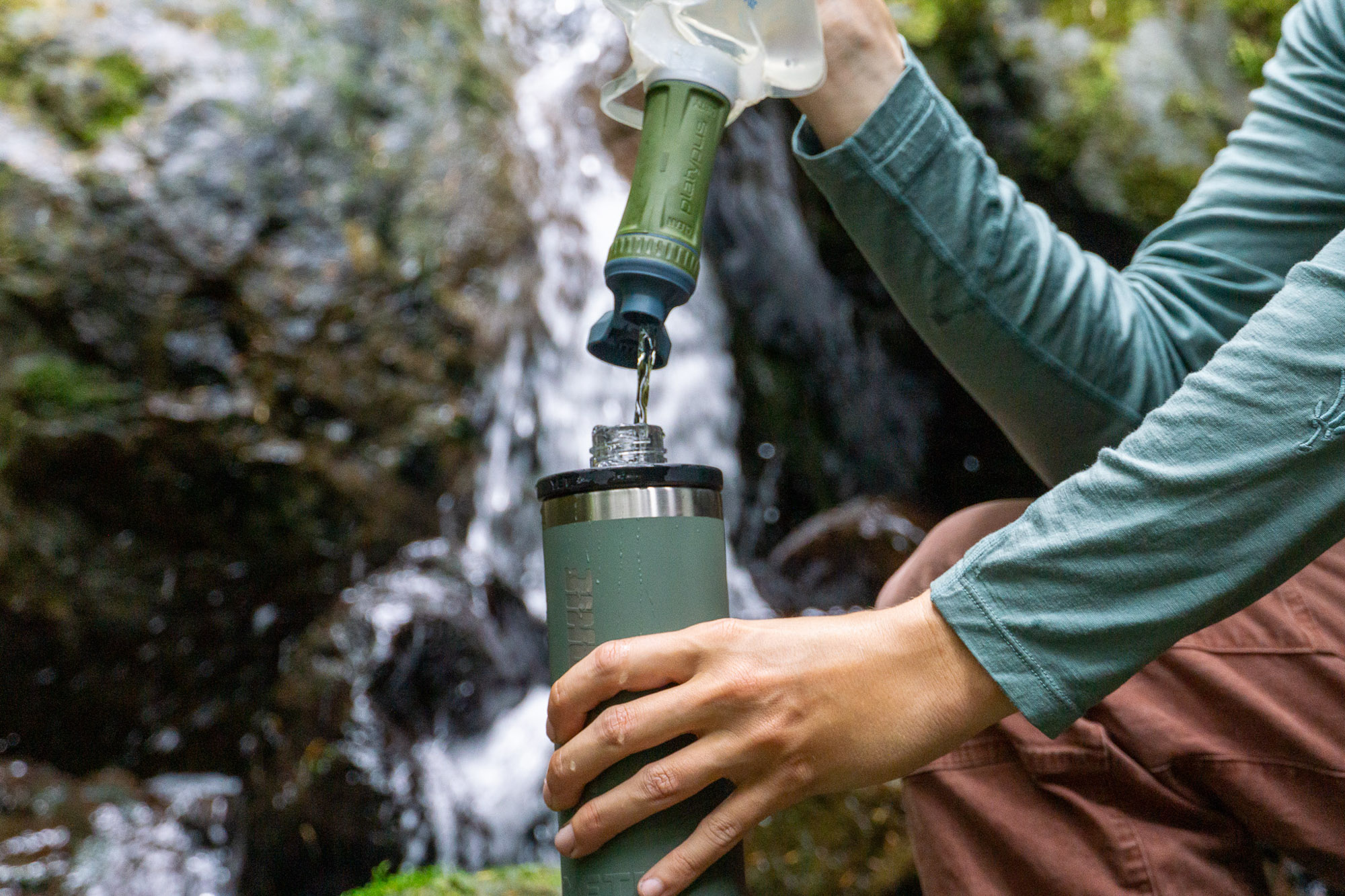
Outside of the field, I also put these filters through a more standardized set of tests in order to get some hard numbers on performance. Most filters these days work spectacularly, so in many cases, the decision to recommend one over another comes down to a few more pumps of a filter.
Independently verifying weights and packed sizes is a quick and easy way to ensure I don’t upset the weight weenies on staff. I also weigh systems together to ensure I’ve got the full picture. Flow rates, too, are a simple test to compare side-by-side with manufacturer claims and are important to independently verify outside of the field.
Finally, as a true test of grit, I whip up a rather dingy soup from our compost bin as a final test for these filters. It’s a tough test meant to bring these systems near to clogging, but it separates the just-OK filters from the winners. It also sets the scene perfectly to execute my cleaning tests, where I sample the ease of restoring a filter to close-to-new functionality.
Our Expert Testers
Guide author Mary Murphy curated our initial selection of 14 filters back in May 2020. A prolific backpacker, Mary knows the value of a reliable filter for constant, dependable hydration in the backcountry. Tester Chris Carter took over this guide in August 2022 and has been digging through his gear closet and scouring the internet ever since to bring you the most current, deserving selection possible.
I, Senior Editor Nick Belcaster, now lead our testing efforts on backpacking water filters. From thru hikes to alpine climbing in the Cascades, solid access to clean water is essential for my adventures, and I’ve had to drink from some pretty dismal sources.
Our Water Filter Rating System
I’ve settled on a few key metrics to rate and compare these filters side by side, so you’ve got the full picture when deciding which is best for your next backpacking trip.
Treatment Time
When comparing treatment time, 1 liter per minute is the standard to earn an average rating here, with filters moving faster than this earning a higher score. I also consider the overall setup time when figuring this rating, as some filters are gulp and go, and some require laborious pumping.
Ease of Use
I also rate these filters on their relative ease of use, and consider how simple they are for both experienced and new backpackers, as well as how many moving parts there are, and how simple any cleaning process is.
Durability
We test these filters over entire seasons of use, and I look at both the durability of any filter elements, as well as connection interfaces or built-in bladders or flasks. Some filter systems are notorious for losing o-rings, while others are supremely overbuilt and will last for years.
Weight & Packed Size
Finally, ounces make pounds in a backpacking pack, and I look for filters that are lightweight and compact when rating them here. Hollow fiber filters should be below 3 ounces to earn a high score, while full gravity systems should aim to be below 1 pound to score well.
Buyer’s Guide: How to Choose a Water Filter
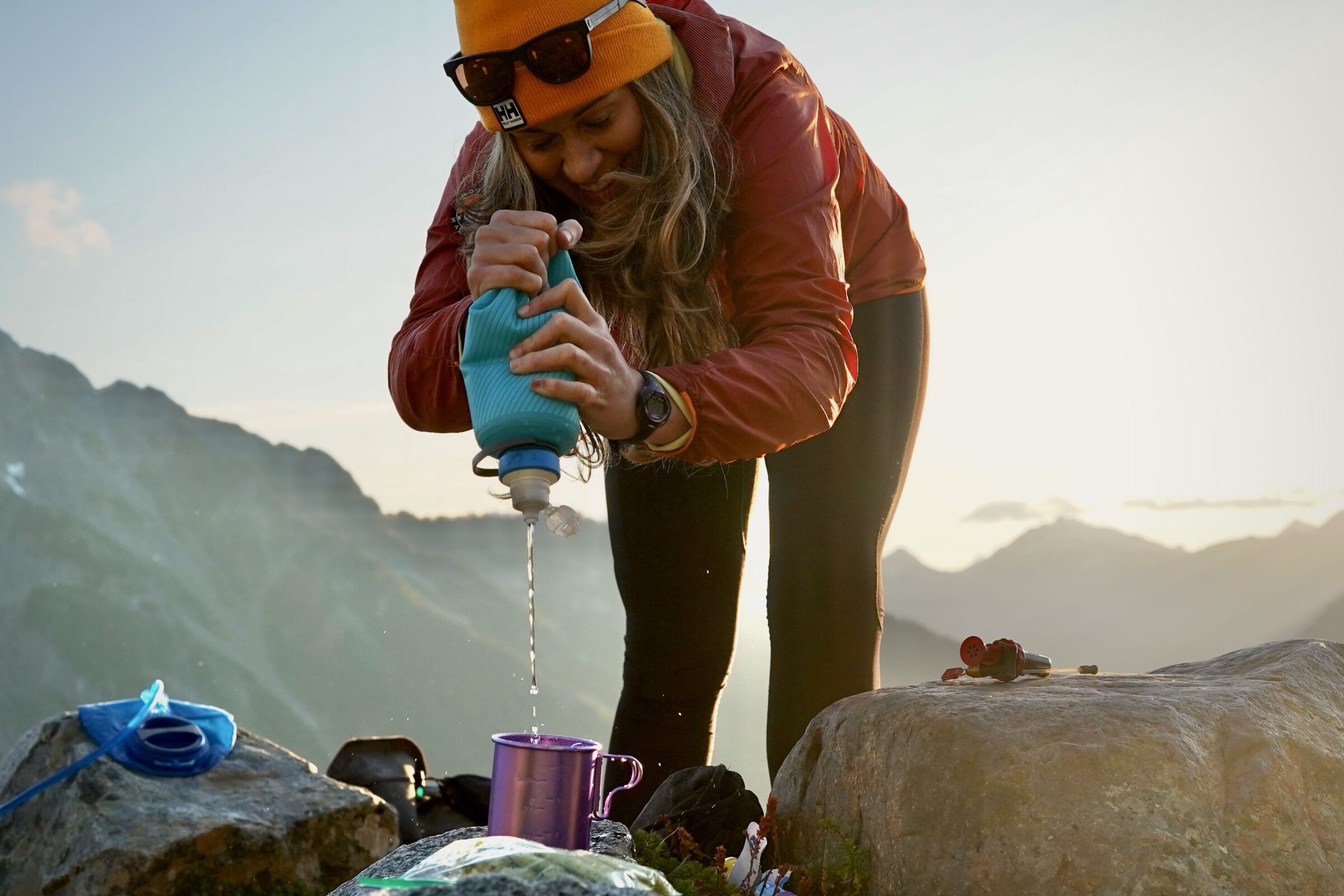
Filters vs. Purifiers
Water filters and purifiers work in similar ways, but it’s helpful to know the difference when choosing. Filters protect against protozoa or parasites (such as cryptosporidium and giardia) as well as bacteria (like E. coli or salmonella), microplastics, dirt, and debris.
Bacteria are the main concern when drinking from unsafe water sources in the backcountry or remote areas, and any filter will sort out these nasty bugs. Popular filters include the Platypus QuickDraw and Sawyer Squeeze.
Purifiers go an extra step by protecting against and filtering out viruses. This is more of a concern when you’re traveling internationally or to rural places where clean water may not be accessible. Products like the MSR Guardian and Grayl GeoPress Bottle will purify your water while also filtering out larger debris, while purifiers like the SteriPEN Adventurer use UV light to purify water, but won’t clear the water of visible dirt and sediment. You can run the water through a bandana or t-shirt first before using these types of purifiers to clean out the biggest particles.
For truly heinous dirty/stagnant water, it can be wise to use several different methods to ensure you don’t get sick. Some will filter their water with something like the Platypus QuickDraw and then boil it, add a purification tablet like Katadyn’s Micropur M1 tablets, or add a couple of drops of bleach to ensure everything is killed. This can be time-consuming and make the water taste interesting, but it’s far better than catching a trip-ending sickness in the wilderness.
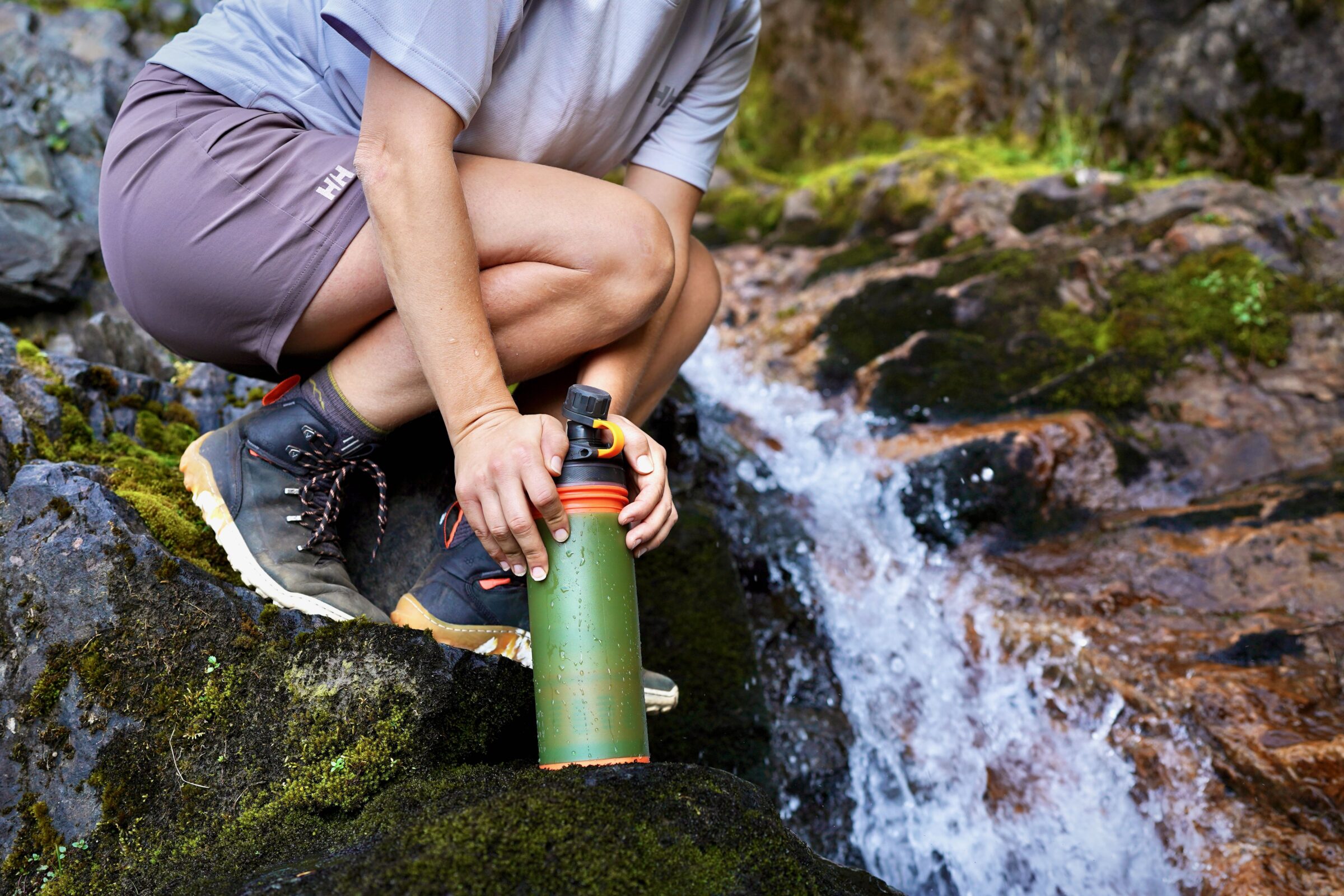
Types of Water Filters
There are various types of backpacking water filters, and I cover a wide range of them in this guide. Each one has its place in the backcountry, and which type you choose will depend on how clear the water will be on your adventure, how lightweight you are trying to go, and if you are traveling internationally.
Gravity and Inline Filters
These filters use gravity to pull water from a dirty bag through a filter and into a clean bag or directly into your mouth. These are often the easiest filters to use as you simply hook it up to a tree branch or tent and wait. They are also usually heavier and take some time to set up, so aren’t the best options for fast and light missions. They tend to work best for large groups or to keep around a base camp.
Gravity filters allow you to keep a large amount of water handy, but they can be difficult to fill up in shallow water sources, so keep that in mind when choosing a campsite. I found the Katadyn BeFree Gravity filter to be one of the best options for large group trips.

Inline filters are often used in gravity systems, but they can also be paired with a hydration pouch or water bottle for quick use. Filters such as the ubiquitous Sawyer Squeeze or the Platypus QuickDraw can be used in this way.
These generally rely on the user sucking the water from a pouch or water bottle, through the filter, directly into their mouth. With the correct adapters, several models of inline filters can be used with a hydration pack you may already be carrying, offering easy filtration without adding much weight.
Straw Filters
While I don’t recommend them as your primary method of water filtration in the wild, straw filters are undeniably one of the easiest ways of procuring fresh water fast. My favorite budget filter, the LifeStraw Personal, fits this bill. These filters are great for trail running, mountain biking, or as a backup to your primary filter. They allow you to get down and dirty by a stream or lake and drink directly from the source by sipping the water through the filter like a straw.
The main downside to straw filters is that they don’t offer any way to carry filtered water with you, unless you can fit the straw into a water bottle of dirty water you are carrying with you, which can be really annoying. It can also get frustrating having to practically lie down on muddy or rocky banks to get a drink anytime you get thirsty. These filters suffice for day hikes, but you’ll probably want something different for any extended backpacking trip.
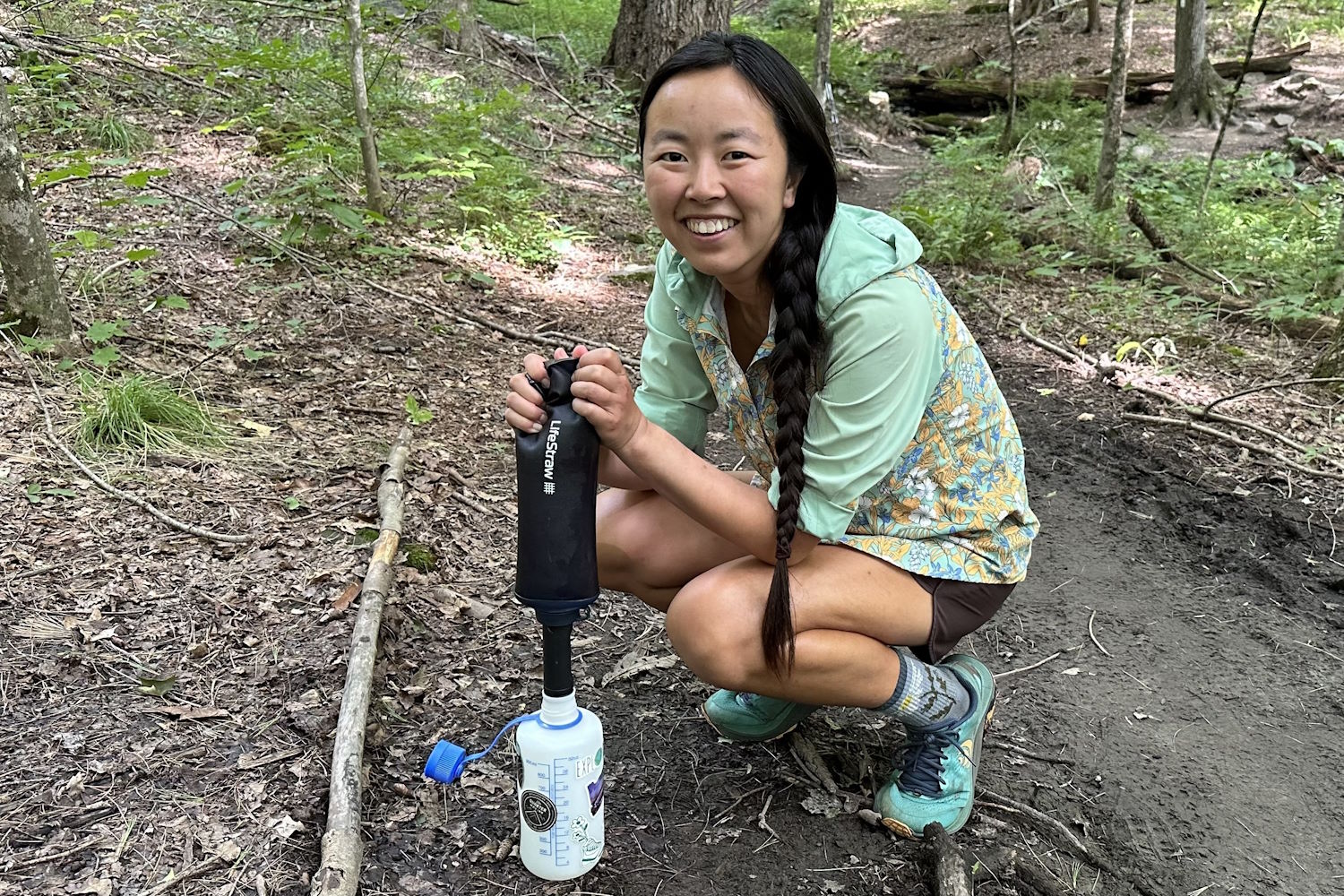
Pump Filters
Pump filters, such as the MSR MiniWorks EX, work great for pulling water out of shallow pools or creeks and can be a solid choice for small backpacking groups. They tend to run on the heavy side, take a little more effort to use, and can be quite complicated to clean. For these reasons, you don’t see as many pump filters in the backcountry as you used to, but they do still have their place.
In some cases, as with the MSR Guardian, pump filters do a better job of purifying truly nasty water by removing viruses, bacteria, and protozoa, such as E. coli, giardia, and cryptosporidium. This is something to consider a little more seriously while adventuring internationally.
Water Filter Bottles
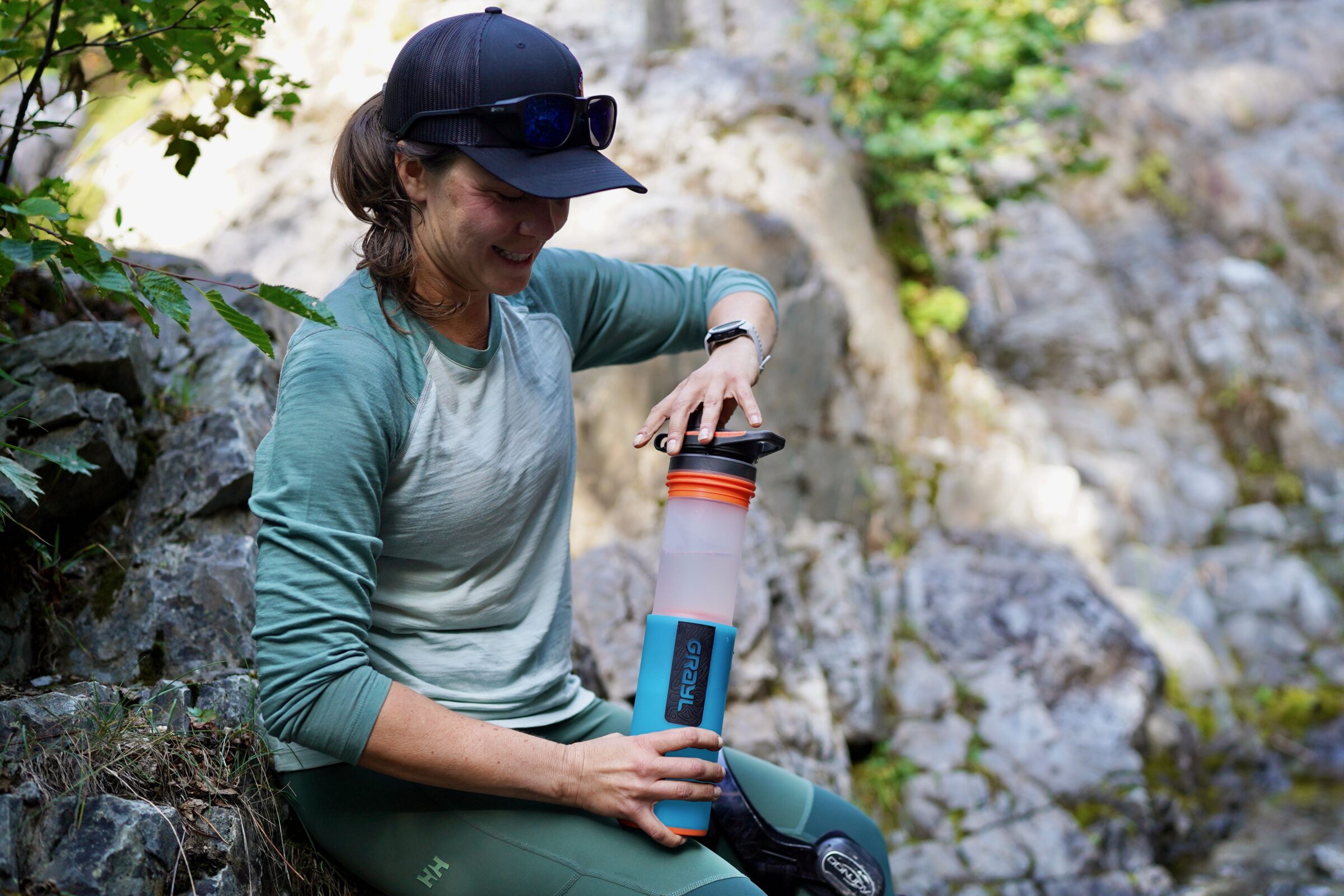
Water filter bottles are handy for traveling, road-tripping, or light hiking, but they are often heavy for dedicated lightweight backpacking trips. Some of these bottles, like the LifeStraw Go Filter Bottle, filter water with a simple hollow-fiber straw that extends from the nozzle into the water, while others use fancier technology to deliver a pure, fresh swig.
The Grayl GeoPress uses electroabsorption and activated carbon to purify water by simply pressing it firmly on the ground. This isn’t your average Nalgene! If you want to nerd out a little more, check out our in-depth review of the GeoPress.
Chemical/UV Purifiers
Finally, purifying your water chemically or with UV light is another simple way to target viruses that may be present in a water source, as opposed to just bacteria and protozoa. Chemical purifiers use iodine or chlorine dioxide to deal with contaminated water, while UV purifiers employ ultraviolet rays.
Some backpackers will also use bleach to treat their water (two drops per liter, then wait 30 minutes). This is a super simple solution but does leave your water tasting, well, somewhat like a pool.
We like Katadyn’s Micropur M1 tablets for chemical treatment, as they tend to leave a more subtle aftertaste compared to other brands. The SteriPEN Adventurer has been our go-to UV filter for its long lifespan and light weight.
This is a great way to purify your water more effectively, but since these don’t have filters with them, it’s important to use them with clear water that doesn’t have a lot of debris in it. Chemical or UV purifiers are lightweight and simple, but should probably not be used as your primary method of filtration on a backpacking trip.
It’s hard to get filtered water fast — they can leave an unsavory aftertaste and sometimes rely on batteries and electronics (in the case of UV purifiers). Since they are so light, however, it’s always a good idea to have them as a backup.
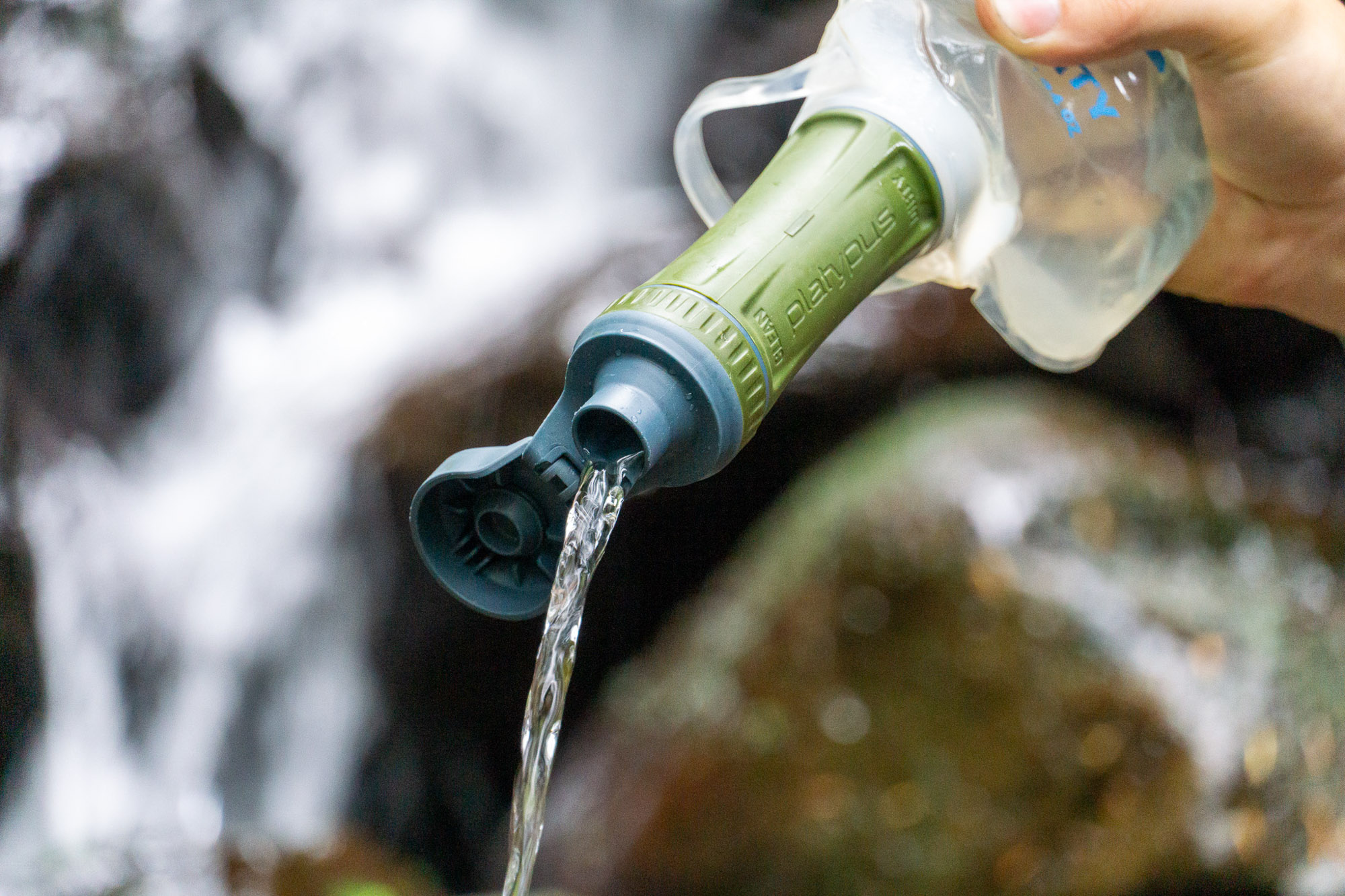
Filter Pore Size
Any filter that uses a membrane to separate the nasty bits from your water (note: not chemical or UV filters) will do so through pores in the membrane material. These pores are measured by their micron size, and they’re a good indicator of not only how effective your filter is but also how fast it will filter water.
For example, the Sawyer Squeeze filters down to 0.1 microns, which is just about the standard you’ll see. This is fine enough to catch particulates, bacteria, and protozoa, but not small enough to nab viruses.
Alternatively, the Platypus QuickDraw uses a 0.2-micron membrane, which filters the same way but at a higher flow rate. On the trail, this means you can filter more water faster.
If you’re adventuring somewhere with especially sedimented water, such as rafting the Grand Canyon, an extra step is usually necessary to keep your filter elements from clogging prematurely. That is, unless you’re using the MSR Guardian, which backflushes the filter with every pump. For every other type of filtration system, use a flocculant such as alum powder (easy to snag in any grocery store), which will accumulate and settle the sediment for you.
Filter Time & Flow Rate

My picks for best water filters vary widely in terms of how quickly they can filter water, ranging from 30 seconds to 30 minutes to 4 hours (chemical treatments). Types of filters and methods of purifying will play a part, as will flow rate.
Flow rate is a unit that measures how quickly a certain amount of water can be filtered. Flow rates for gravity, pump, or squeeze filters listed here vary anywhere from 1L to 3L per minute. If you are encountering a slow flow rate with your filter, it may require priming or backflushing.
Similar to needing to prime a stove, some water filters require priming before initial use. Check the instructions (it varies by filter) on how to do this. Backflushing is a process where you need to clean water out of the filter system after use. This mainly applies to filters with pumps, tubes, or tubing, and it ensures that the inside of the filter stays dry and clean.
Another consideration here is location: if you are going to be traveling through a desert landscape, there may be few to no trees (a necessity to hang some gravity filters properly). For that type of setting, a different style of filter would be best.
And if you are going to be traveling with a companion or group, the personal LifeStraw filter obviously won’t be the best option (although I love it as a backup!).
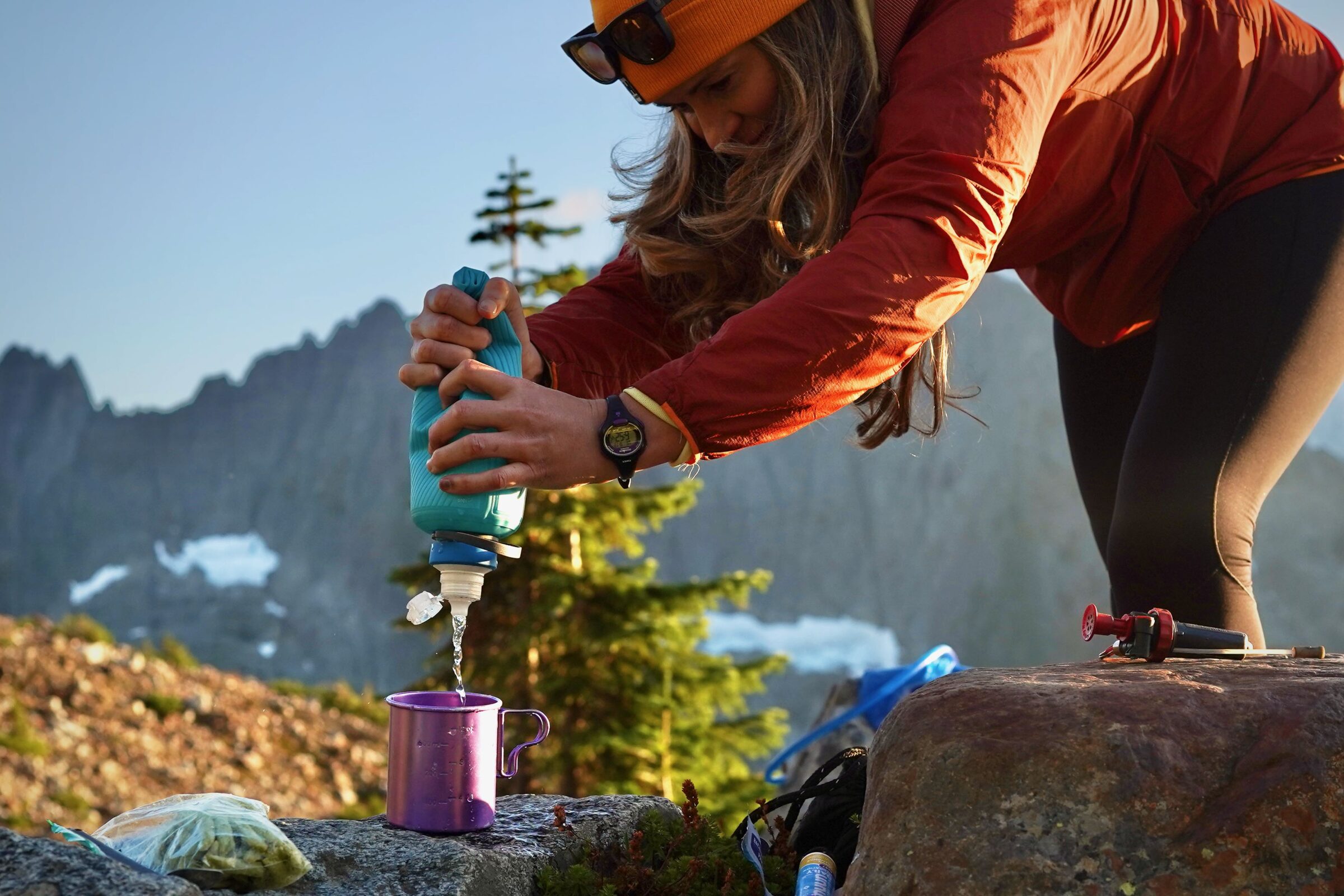
Packed Size
This is an important point for ultralight setups and lightweight backpackers. You’ll want to choose a filter that works best for you and how much water you’ll need, but one that can also fit in your pack.
Filters like the Platypus QuickDraw and Katadyn BeFree AC are popular because the actual filter unit is so small and weighs close to nothing. The QuickDraw weighs just a couple of ounces, while the Katadyn weighs 6.8 ounces (but remember, it can filter up to 3 L of water at a time).
Filter systems that have water reservoirs and tubing also roll and pack down fairly small. My personal preference on group trips is a gravity filter system, whereas on solo trips — though they weigh slightly more — my preference is a water bottle filter/purifier, given that I always carry a 1L bottle anyway.

Durability & Longevity
A filter’s lifespan greatly depends on its filter method (cartridge, hollow membrane, chemical, or UV light). Backpacking water filters can last anywhere from 250 to 4,000 L. Cleaning your filter regularly using the methods that the manufacturer recommends will also help prolong its life.
Filters that use a cartridge tend to last anywhere from 200 to 500 L before you need to replace the cartridge. On the other hand, with other filters that last longer, you may need to replace the entire unit at the end of its life. The LifeStraw is an example of this; it can filter around 4,000 L, and then it will stop working and need to be replaced.
For UV methods like the SteriPEN, it’ll last forever as long as you charge or continue to replace the batteries (barring any damage, of course).
Filter Failure & Integrity Testing
Water filters with a filtration element aren’t bulletproof and can fail if allowed to freeze, causing the fragile membranes to break. If this happens, your filter won’t fully treat water passed through it. Thankfully, the workaround is simple: when temperatures look like they’ll dip below freezing, toss your filter in your sleeping bag to keep warm.
If you’ve had a chilly night and forgotten your filter (it happens to the best of us) or potentially dropped it, an integrity test is in order. Filters like the Platypus QuickDraw instruct on how to do this, but the process will work for other hollow fiber filters as well, like the Sawyer Squeeze.
First, backflush a minimum of ½ L of water through the filter, and then empty the dirty water bag and reattach it to the filter. Introduce air into the filter by either squeezing the empty bag or, in gravity filters, by blowing air through the clean side. If air bubbles pass through the other side of the filter element, your filter is compromised and should be replaced.

Price & Value
There’s a bit of a spread when it comes to backcountry water filters, and without a little context, you might be led to believe that more money = more filtration. Instead, consider that there are a number of factors that go into just how much filter you might want to spring for: group size, water quality, and storage needs are just a few.
Budget
If you’re solo more often than not and find that day hikes are more your speed, it can be easy to jump into a budget filter that’s quick to deploy and drink straight from the source. Know that these types of ‘straw’ filters won’t give you any storage capacity for the long haul, but for out-and-back endeavors where water is plentiful, they can do the trick.
The LifeStraw Personal ($20) is an excellent example of this, and our fly fisherfolk on staff have come to lean on this filter as a go-to for quick and easy drinking while on the river. Chemical treatments such as Katadyn Micropur ($16) can be cheaper still, but we’d caution that this type of filtration is better suited to some specific use types — such as rivers with high glacial silt content.
Mid-Tier
Bumping up a bit in price nets you a great deal more in the world of backpacking filters. Even shelling out $40 to $100 can get you a hollow fiber filter that will last for 1,000+ liters and move enough water to make personal trips to refill quick and easy. These filters often offer additional water bladders to filter from and backflushing syringes or hosing to connect to hydration systems.
Our top pick, the Platypus QuickDraw ($55), is a great value for the money. You’ll pay a bit extra for the large 2 or 3L bladders, but the flow rate and ease of use make it well worth it. This price range is also where you can get into some different styles, such as a gravity filter like the Katadyn BeFree Gravity 3L ($75) or Grayl GeoPress ($100) bottle filter.
Premium
Going with a premium filter option means that you’ve either got a lot of people to get water to, or are headed somewhere where the water is consistently challenging to filter. Anything north of $100 is likely to either be a pump filter or a complicated gravity system, and will use additional filter elements such as activated charcoal to strip out odors and heavy metals — improving taste.
The MSR Guardian ($400) is the mack daddy of pump filters, and, honestly, it’s a bit overkill for most of North America. That’s why we suggest the MSR MiniWorks EX ($125) as a better option for most folks. The MSR Guardian Gravity Purifier ($300) is similarly overbuilt compared to the pump version and builds on a charcoal filter and 10L (!) capacity to get an entire platoon watered.
Frequently Asked Questions
The best way to clean your water when backpacking is to use and find the cleanest water source possible. You’ll want to look for clear, running water — somewhere between a babbling brook and a rushing river.
Avoid stagnant ponds or areas where there might be runoff (from livestock, urban areas, etc.) or debris. You’ll also want to find a safe place to refill, pump, or hang your gravity filter.
With some filtering methods, like chemical filters and tablets, you’ll want to wait longer to ensure that the water is clean if it’s below a certain temperature (or cloudy).
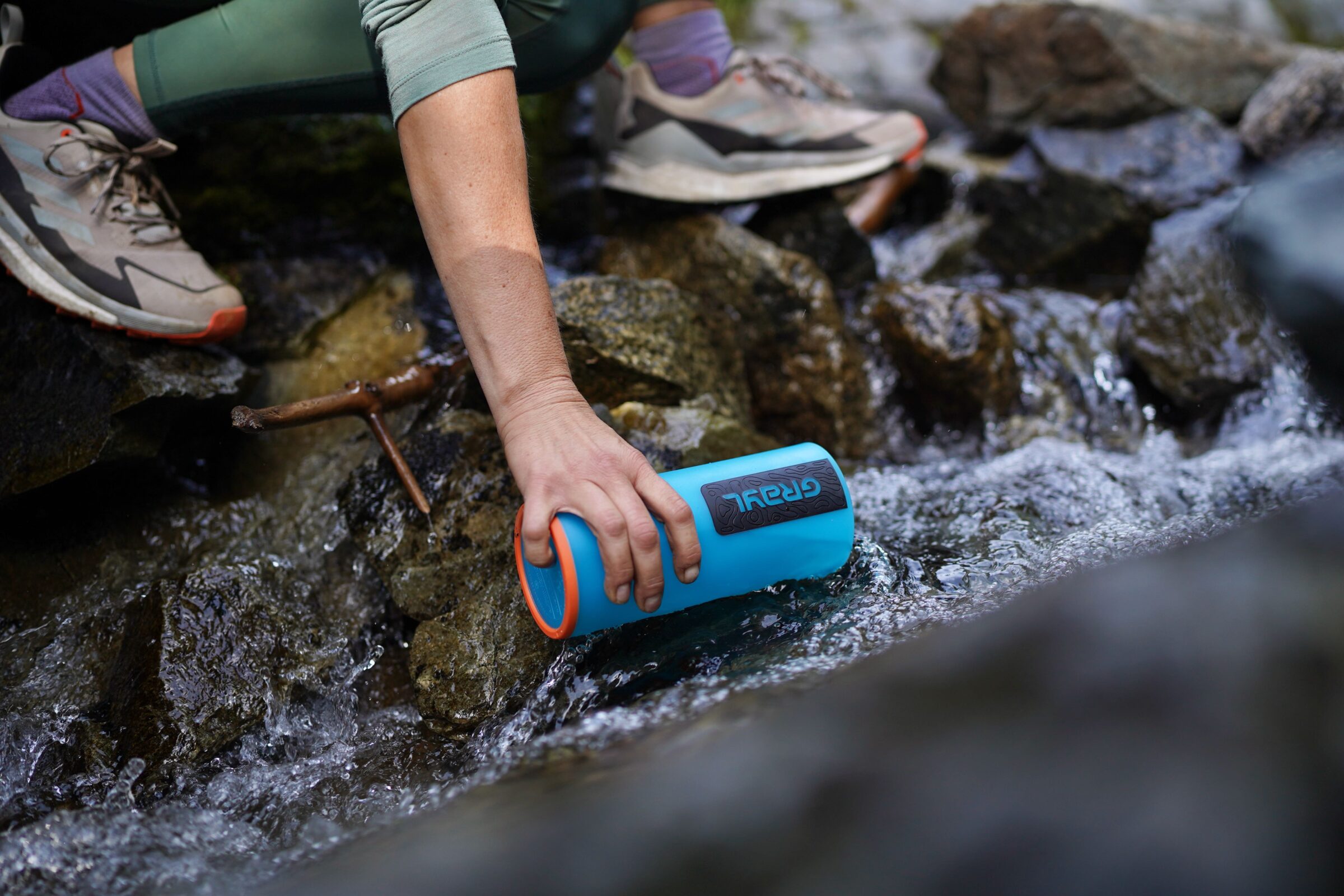
Filters most commonly use a tube, pump, or gravity method of filtering. Purifiers use a combination of a tube or chamber with activated carbon or another chemical component to fight against one key difference: viruses.
All of the choices on this list protect against at least bacteria and protozoa, and many also protect against things like toxins, chemicals, and viruses. We recommend choosing the one that will work best based on your situation, budget, and preference.
The lifespan of a filter largely depends on the type of filter. Most hollow fiber or activated charcoal cartridges will need to be replaced every couple hundred uses, or after a certain number of liters have been filtered. Some filters, like the LifeStraw, can last for years, but when it’s run its course you’ll need to buy a new one.
There are also some filters and purifiers that just need new batteries or to be charged.

Yes! Purifiers like the Grayl GeoPress Purifier are built especially to filter and protect against everything you could encounter, whether in the backcountry or in a developing country.
As long as you are following the instructions on your filter or purifier, it will protect against whatever it’s rated for (usually something like 99.999999% of bacteria and 99.999% of parasites and microorganisms).
My top two considerations when buying gear like this are always: (1) how often we will be using it, and (2) price. Another important factor for many is how long a filter will last. If you backpack or hike 9-12 months out of the year, you probably want to drop more money on a filter that has a longer lifespan.
When all else fails, you can boil water to be safe. But let’s be honest, having a water filter on hand is much better.


The Best Insulated Water Bottles of 2025-2026
Never go thirsty again. We tested the best insulated water bottles to keep your bevvies cold and flowing freely. Check out our top picks from Hydro Flask, Stanley, YETI, CamelBak, and more..

The Best Backpacking Stoves of 2025
The right stove makes life on the trail better. From ultralight canisters to four-season and multifuel options, we’ve found and tested the best backpacking stoves.


